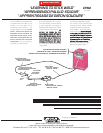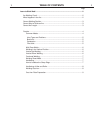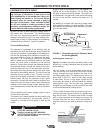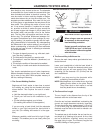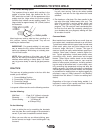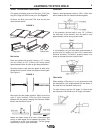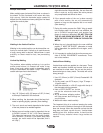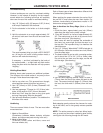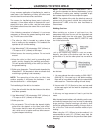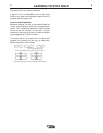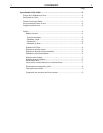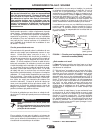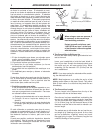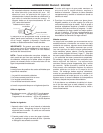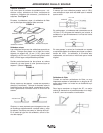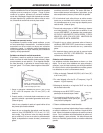
4
LEARNING TO STICK WELD
4
4. The Correct Welding Speed
The important thing to watch while welding is the
puddle of molten metal right behind the arc. Do
NOT watch the arc itself. It is the appearance of the
puddle and the ridge where the molten puddle
solidifies that indicate correct welding speed. The
ridge should be approximately 3/8" (9.5mm) behind
the electrode.
Most beginners tend to weld too fast, resulting in a
thin, uneven, “wormy” looking bead. They are not
watching the molten metal.
IMPORTANT: For general welding it is not neces-
sary to weave the arc; neither forwards and back-
wards nor sideways. Weld along at a steady pace.
You will find it easier.
NOTE: When welding on thin plate, you will find
that you will have to increase the welding speed,
whereas when welding on heavy plate, it is neces-
sary to go more slowly in order to get good penetra-
tion.
PRACTICE
The best way of getting practice in the four skills that
enable you to maintain:
1. Correct Welding Position
2. Correct Way To Strike An Arc
3. Correct Arc Length
4. Correct Welding Speed
is to spend a little more time on the following exercise.
Use the following:
Mild Steel . . . . . . .Plate 3/16" (4.8mm) or heavier
Electrode . . . . . . . .1/8" (3.2mm) Fleetweld® 180
Current Setting . . . . . . . .105 Amps AC
or 95 Amps DC(+)
Do the following:
1. Learn to strike the arc by scratching the electrode
over the plate. Be sure the angle of the electrode is
correct. If you have a headshield use both hands.
2. When you can strike an arc without sticking, prac-
tice the correct arc length. Learn to distinguish it by
its sound.
3. When you are sure that you can hold a short, crack-
ling arc, start moving. Look at the molten puddle
constantly, and look for the ridge where the metal
solidifies.
4. Run beads on a flat plate. Run them parallel to the
top edge (the edge farthest away from you). This
gives you practice in running straight welds, and
also, it gives you an easy way to check your
progress. The 10th weld will look considerably bet-
ter than the first weld. By constantly checking on
your mistakes and your progress, welding will soon
be a matter of routine.
Common Metals
Most metals found around the farm or small shop are
low carbon steel, sometimes referred to as mild steel.
Typical items made with this type of steel include most
sheet metal, plate, pipe and rolled shapes such as
channels, angle irons and “I’’ beams. This type of
steel can usually be easily welded without special pre-
cautions. Some steel, however, contains higher car-
bon. Typical applications include wear plates, axles,
connecting rods, shafts, plowshares and scraper
blades. These higher carbon steels can be welded
successfully in most cases; however, care must be
taken to follow proper procedures, including preheat-
ing the metal to be welded and, in some cases, care-
fully controlling the temperature during and after the
welding process. For further information on identifying
various types of steels and other metals, and for prop-
er procedures for welding them, we again suggest you
purchase a copy of (“New Lessons in Arc Welding”
available from the James F. Lincoln arc welding foun-
dation).
Regardless of the type of metal being welded, it is
important in order to get a quality weld that it be free
of oil, paint, rust or other contaminants.



